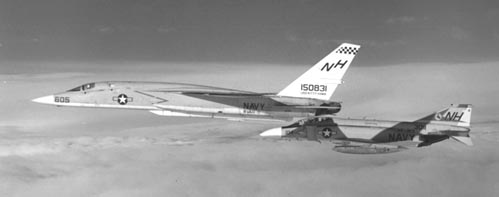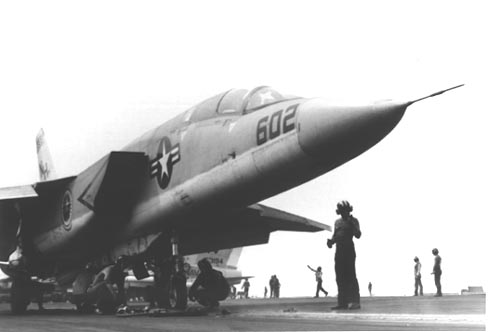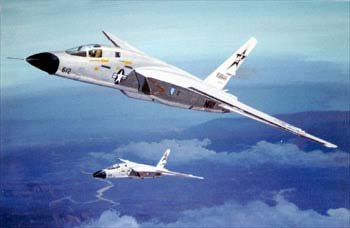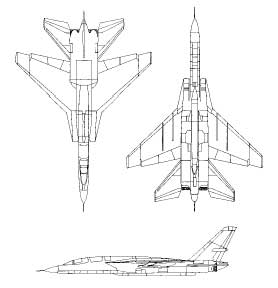|
The "Vigilante" flew for the first time in June 1962. It embodied the same modifications that had been incorporated into the A-5B with a few minor changes, the main one being the addition of a under fuselage mounted "canoe" that carried most of the reconnaissance sensors. The RA-5C retained its capability for carrying underwing ordnance, although it was rarely, if ever, used.
The first RA-5C was delivered on in June 1963 and the aircraft entered service during 1964 . The aircraft answered a U. S. Navy need for a capable, manned, long-range reconnaissance system to augment short range tactical systems, such as the RF-8G Crusader.
The RA-5C "Vigilante" incorporated a sophisticated electronic reconnaissance pod in its bomb-bay that included a side-looking airborne radar in a fairing under the fuselage, vertical, oblique and split-image cameras as well as active and passive ECM equipment. Production deliveries began in mid-1964 and shortly thereafter the RA-5C began flying reconnaissance missions over Vietnam from carriers in the Gulf of Tonkin.
An inertial navigation system (INS) combined with an automatic flight control system enabled the RA-5C to fly precise courses on mission altitudes ranging from high to tree-top levels. Each photo taken carried a marginal notation that displayed latitude and longitude of the plane at the time it was taken, thus pinpointing target locations. The information obtained was then incorporated into a shipboard data bank and used for mission planning.
Several RA-5Cs were also outfitted with a probe-and-drogue refueling package to serve as "buddy tankers" for compatible aircraft.
|
RA-5C Reconnaissance Capabilities |
Reconnaissance sensors included:
• A SLAR (Side Looking Airborne Radar) unit
• Photographic equipment, which included vertical, oblique, and split-image cameras, and 3 inch and 18 inch horizon-to-horizon panoramic scanning cameras. (The SLAR and the cameras were carried in a long external under-fuselage faring, called the canoe.)
• A television camera capable of functioning in very low light was mounted under the nose just behind the radome.
• A sensor for gathering electromagnetic intelligence (Passive Electronic Counter-measures (PECM), which replaced one of the 3 fuel tanks, was in the linear weapons bay.
• Two high-intensity super sonic strobe-type flasher pods were mounted on the underwing pylons to illuminate the ground under the aircraft.
• The DDS (Digital Data System) encoded data on each exposure indicating all the statistical data (altitude, latitude, date, etc, etc.) which identified exactly where the photo was taken. This was invaluable to subsequent air strikes against camouflaged targets that were recognized when aerial infrared film was used.
The RA-5C formed the airborne reconnaissance unit of the Integrated Operational Intelligence System (IOIS). The Integrated Operational Intelligence Center (IOIC), the shipboard part of the system, process the electronic and photographic information collected by the RA-5C. Housed within the IOIC was an electronic intelligence data handling center, a one-hour photo processing center whose equipment (Kodak EH-38 high speed processors) was highly classified at the time (now this same type of equipment is readily available at most shopping malls for one hour processing). After processing the film it was read out by specialists at interpretation of the images electronic data analysis.
Prototypes of the reconnaissance system worked so well that all surviving A-5A and A-5B aircraft were returned to North American Aviation's Columbus, Ohio facilities to be modified to RA-5C standards. The demonstrated ability of the RA-5C to meet a long standing need for long range fleet reconnaissance now provided the justification to keep the Vigilante in production. (NOTE: The prototypes worked much better than they did in actual operation).
During the 1960's, a total of forty-three standard RA-5C's were built, these following closely on the heels of the eighteen original A-5B aircraft.
When the last of these rolled off of the Columbus, Ohio assembly line, it appeared that the Vigilante production had come to an end. Accordingly, tooling and related hardware was placed in long-term storage.
The Columbus facility then shifted its priorities to other projects including the remanufacture of the forty-three remaining A-5A and A-5B aircraft to RA-5C standards.
Attrition caused by the continuing hostilities over Vietnam resulted in renewed Navy interest for acquiring additional RA-5C's, so in 1968 the Navy ordered forty-six new production RA-5C's, restarting the production line. Visually they differed from the previous models only by a leading edge extension which extended from near the wing root to the forward air intake lip. The purpose of this extension was to generate improved airflow over the stabilator at low speeds, enhancing pitch control during the landing approach. These aircraft were all powered by J79-GE-10 engines.
Only thirty-six of these new aircraft actually built, the last completed in August 1970.
|
|
|
The RA-5C in the Vietnam war |
The RA-5C was first deployed to south-east Asia in August of 1964, initially flying missions only over South Vietnam because the Navy was reluctant to jeopardize the aircraft's sophisticated and very expensive equipment, should the aircraft be lost over North Vietnam.
Eventually, the Vigilantes did go North, suffering the highest loss rate of any Naval aircraft in the war. In all, eighteen Vigilantes were lost in combat.
-
• 11 were lost to antiaircraft fire.
• 2 were shot down by SA-2 Guideline surface-to-air missiles (SAM's).
• 1 was lost to an Atoll missile fired from a MiG-21 fighter.
• 4 were lost for unknown reasons, over N. Vietnam.
• 1 other aircraft was lost for unknown reasons, not over N. Vietnam.
Of the 11 lost to antiaircraft artillery, the majority were during post-strike reconnaissance missions; North Vietnamese gunners knew that shortly after a strike a Vigilante would be overhead, without supporting flak suppression.
Thirty-one deployments were made to Vietnam by Vigilante squadrons. During the early period of Vietnam operations, Vigilante squadrons deployed with six aircraft. As the war progressed, this figure began declining, first to five, then to four and finally, by 1974/75, to three aircraft per squadron.
Gradual disestablishment of the "Vigilante" force occurred during 1979-1980 with the deactivation of the last RA-5C squadron, and phasing out of the last of the 156 RA-5/A-3Js produced.
|
|




